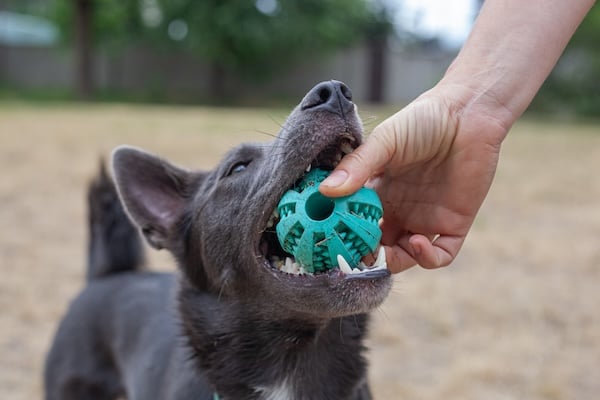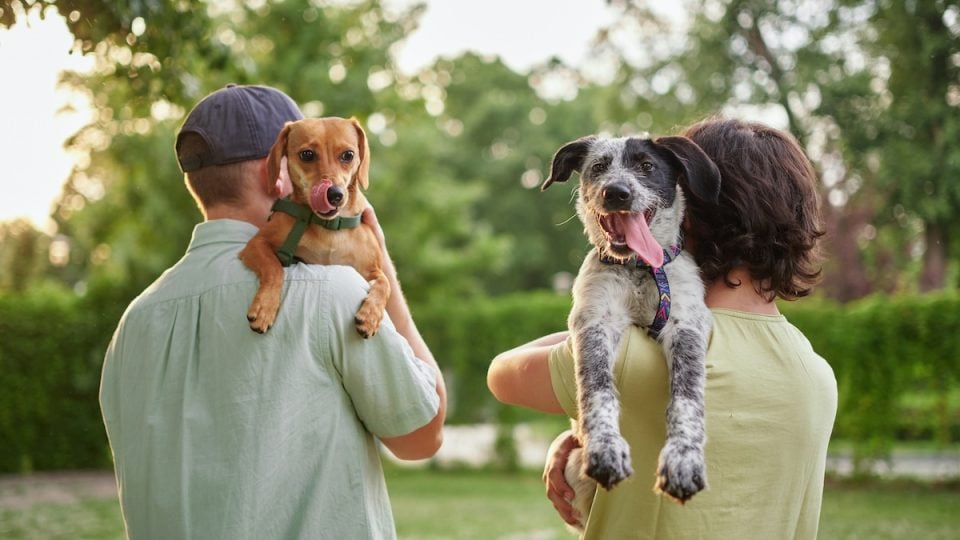- Not a substitute for professional veterinary help.
If you’re getting a new dog, there’s a lot to consider, from their breed and age to their grooming needs and energy levels. But what about a dog’s sex—are there meaningful differences between male vs. female dogs in terms of temperament, behaviour, or health? Is one sex easier to train than the other?
To find out, we dug into the current research on the topic and consulted two veterinarians: Dr Wendy Hauser, DVM and veterinary advisor at ASPCA Pet Health Insurance, and Dr Nita Vasudevan Patel, veterinarian at Embrace Pet Insurance.
Below, we’ll unpack some commonly cited differences between male vs. female dogs, including their behaviour, personality, aggressive tendencies, and compatibility with other pets.
Physical Differences Between Male and Female Dogs
Let’s start with the obvious—male and female dogs have different reproductive and genital systems.
Many of the biological differences between male and female dogs are tied to their reproductive hormones. Testosterone is the primary sex hormone in males and may contribute to behaviours like roaming, mounting, and urine marking.
In females, the ovaries produce oestrogen and progesterone, which regulate their heat cycle and contribute to behavioural changes like agitation and receptiveness to males. Neutering or spaying a dog will reduce behaviours driven by sex hormones.
There are size differences between males and females, too. Male dogs tend to be larger (both in height and weight) than female dogs, and with this greater size comes greater physical strength. It’s something to keep in mind if you might struggle with a bigger, stronger dog on lead.
Do female dogs have periods?
Female dogs do not have monthly periods like humans. However, they do go through an oestrus cycle, commonly known as ‘the heat cycle’, which involves vaginal discharge or bleeding.
Going into heat means that the dog is able to carry a litter, and her body will produce a secretion that attracts male dogs. A spayed dog won’t experience a heat cycle and will not be interested in reproduction.
“Unspayed females will go into heat typically twice a year, which can involve behavioural changes and the need for extra care to prevent unwanted pregnancies,“ explains Dr Nita Vasudevan Patel. These behavioural changes may include restlessness and higher levels of aggression.
Temperament Differences Between Male and Female Dogs
Hop on any dog-related forum and you’ll find a lot of opinions about the differences between male and female dogs. But do these anecdotal claims have any truth behind them? We take a closer look.
Temperament & personality
Dr Vasudevan Patel points out that the generalisation about one gender being more affection than others isn’t true for all dogs. How affectionate a dog is depends on how well you understand and can communicate with them.
While more studies are needed, there is some evidence that male and female dogs differ in how they interact with humans. “Females seem to need a job to do,” says Dr Wendy Hauser. “They enjoy problem-solving behaviour that encourages cooperative behaviour from their humans.” Male dogs, on the other hand, may prefer unstructured social play with humans.
However, it’s essential to recognise that these differences are not definitive and can vary widely from dog to dog. In the end, a dog’s temperament is influenced more by their experiences, socialisation, and the environment in which they were raised.

BLACK_FACTORY via iStock
Training
Many people claim that female dogs are easier to train than male dogs—but the research on this is limited. A 2017 study published in Royal Society Open Science found that female dogs demonstrated greater obedience. In theory, this should mean they’re more trainable than male dogs. Females are also said to mature faster, which could make them easier to train.
However, our experts say factors other than sex are at play. “Training success is more dependent on the individual dog’s personality and the consistency of the training program rather than the dog’s sex,” explains Dr Vasudevan Patel.
Challenges with training may arise if a dog is not spayed or neutered because entire dogs can be more easily distracted by their surroundings.
Aggressive tendencies
Some studies show that aggression is more prevalent in male dogs than in female dogs. Even so, Dr Vasudevan Patel emphasises that aggression can occur in both male and female dogs and is more likely influenced by a dog’s environment and socialisation than their gender.
Unneutered dogs of both genders generally exhibit more aggression than spayed or castrated dogs.
Marking and humping behaviour
According to Dr Vasudevan Patel, unneutered male dogs are the most likely to hump and mark their territory. But female dogs can also engage in humping and marking behaviours, she adds.
These behaviours are natural for dogs and aren’t exclusive to one gender. Marking is all about communication: in unneutered dogs, it can signal they’re ready to mate. And dogs may mount people, other dogs, or inanimate objects when they’re feeling friendly or playful.
Compatibility with kids and other animals
Both male and female dogs can get along well with children and other animals—provided they’re properly socialised. “Individual personality and early socialisation play a more significant role than sex,” confirms Dr Vasudevan Patel.
As for certain gender pairings in multi-dog households, compatibility may be more tenuous. Some veterinary behaviourists say the best combinations are dogs of different sexes. Dr Hauser tells us that one study found that female dogs could be more aggressive towards other female dogs.
If you’re concerned about how adding a second dog to your home might play out, our experts recommend focusing on compatible personalities rather than genders.
“For example, if you have an assertive, dominant dog, then selecting a less dominant dog would be advised,” explains Dr Hauser. “If you have a high-energy dog, [they] might prefer a high-energy companion.”

Supitnan Pimpisarn via iStock
Male Vs. Female Dog Health Care
One gender isn’t inherently healthier than the other, and the basic care requirements for male and female dogs are essentially the same. This goes for their diet, exercise, grooming needs, and routine veterinary care. “Exceptions include diseases that are sex-specific and generally related to the reproductive organs,” says Dr Hauser.
For instance, unspayed female dogs can develop mammary gland tumours and pyometra (a serious uterine infection). And unneutered male dogs are at risk of testicular cancer and prostate issues.
Furthermore, male dogs are more likely to experience joint problems like arthritis due to their larger size.
Health-related costs will be similar between the sexes. However, spay procedures are often more expensive than castration surgeries. This is because spaying involves more complicated and time-consuming abdominal surgery.
Which Should You Get?
While a dog’s sex may not be a strong indicator of how well they’ll fit into your family, there are some differences you might want to consider before adopting one over the other.
Pros and cons of female dogs:
- Smaller in size and weight
- Unneutered females will experience a heat cycle twice a year
- Unneutered females are at risk of mammary tumours and uterine infections
- May enjoy cooperative puzzle-solving with humans (though this is a generalisation)
- May be less prone to aggression (but again, this is a generalisation)
Pros and cons of male dogs:
- Larger in size and weight
- Entire males are more likely to exhibit behaviours like marking, mounting, and roaming
- Unneutered males are at risk of testicular cancer and prostate issues
- May enjoy unstructured social play with humans (though this is a generalisation)
- May be more prone to aggression (again, a generalisation)
Ultimately, both experts agree that a dog’s sex shouldn’t be the primary factor when selecting a new pet.
“Male and female dogs can exhibit different behaviours and characteristics, but these differences are often subtle and can be influenced significantly by the dog’s breed, socialisation, and individual personality,” concludes Dr Vasudevan Patel. “It is more important to consider the dog’s temperament, energy level, and compatibility with the owner’s lifestyle.”
Instead of placing emphasis on a dog’s sex, try meeting them and learning about their past experiences to get a feel for how they’ll fit into your life.



